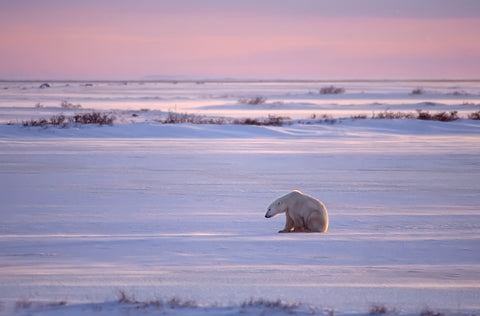What does pollution have to do with polar bears? November 19 2015, 0 Comments
Pollution travels. As long ago as 2005, in a report released by the World Wildlife Fund, scientists documented troubling concentrations of toxic man-made chemicals in the Arctic. Effluents of far-distant human industry and agriculture, hazardous chemicals including pesticides, fertilizers, and flame retardants, ride north on currents of air and water. Airborne toxins fall to earth in rain or snow. Arctic wildlife is now exposed to a witches’ brew of unintended poisons.
A report called “Killing them softly….Health effects in arctic wildlife linked to chemical exposures,” from the WWF International Arctic Programme and WWF-DetoX, provides a useful and disquieting overview of multiple scientific studies (http://tinyurl.com/pbears-toxins). These examine adverse changes in arctic birds, seals, sea lions, beluga whales--and polar bears--exposed to chemical toxins.
“Killing them softly” reports polar bears are at particular risk for several reasons:
1. Food
Polar bears, the largest land-dwelling carnivores on earth, are apex predators. Excepting only man, polar bears occupy the very top of the arctic food chain. Their prey has been exposed to chemical contaminants, but so has the prey of their prey, and the prey of that prey. Through the natural process of animals eating other animals, toxins move up the food chain, producing the richest mix and heaviest concentration at the top--where the polar bear waits.
2. Fat
Polar bears are fitted to survive the terrific arctic cold by a thick insulating coat of fat--and fat is particularly suited to harbor chemical toxins. The fat of other animals, in particular the blubber of ringed seals, makes up much of the polar bear’s diet--suitable for maintaining warmth and energy in the harrowing cold, but also rich in chemical contaminants.
3. Mother’s Milk
Female polar bears nurse their young for as long as two years. The rich, fatty milk essential to the cubs’ survival and development now comes to them laced with chemical toxins.
4. Lifespan
Polar Bears International reports that free-ranging individuals have been known to live more than 30 years, but the average lifespan of a wild polar bear is 15 to 18 years (http://tinyurl.com/pbearlifespan). This is a long stretch when seen in terms of the accumulating effect of chronic exposure to toxins.
“Killing them softly” reports starkly that “Arctic-wide studies have confirmed polar bears are heavily contaminated with chemicals.” It speaks to the consequences of this contamination for polar bears, linking chemical exposure to an array of adverse physical effects; among these are damage to the immune system, hormonal disruptions sufficient to impact learning ability and behavior, and challenged reproductive health.
None of this is to say toxic pollution is the primary threat to the long-term survival of polar bears: that distinction belongs to climate change (a topic to which I will come back in future posts).
However polar bears in damaged health are by definition less able to withstand the rigors ordinary in arctic life--let alone to survive in the face of climate change, habitat loss and long-term hunger. By itself, reducing toxic pollution cannot hope to save them; it can diminish the assaults on their health, and in that way help give them a fighting chance.

